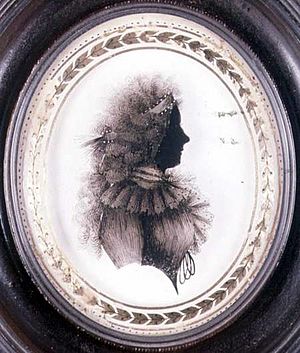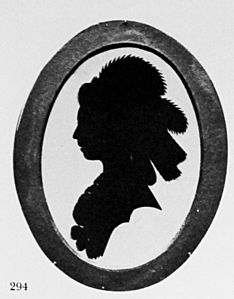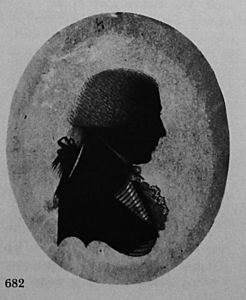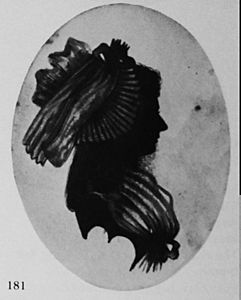Isabella Beetham facts for kids
Quick facts for kids
Isabella Beetham
|
|
|---|---|
| Born |
Isabella Robinson
1750 to 1754 |
| Died | August 1825 Somers Town, London, England
|
| Nationality | British |
| Education | John Smart |
| Known for | Silhouette artist |
| Spouse(s) | Edward Beetham |
Isabella Beetham was a talented British artist from the 1700s. She was famous for creating beautiful silhouette portraits. At first, she made these pictures by cutting shapes from paper. Later, she learned to paint from a well-known artist named John Smart. After that, Isabella painted her silhouettes, often on glass, to be framed. She also made tiny portraits for jewelry.
From 1785 to 1809, Isabella ran a successful art business in London. Her studio was on Fleet Street, a busy area. She created many silhouettes of both men and women. Today, she is known as one of the best silhouette artists of her time.
Contents
Isabella's Early Life and Family
Isabella Robinson was born around 1750 to 1754. Her family was Roman Catholic. Her father and grandfather were both named John Robinson. Her father was from Sedgefield, and her grandfather was an architect from Lancaster.
In the early 1770s, Isabella met and married Edward Beetham. Edward was born in 1744, making him a bit older than Isabella. Both Isabella and Edward came from wealthy families. However, their families did not approve of their marriage. Because of this, they stopped supporting the couple financially.
Edward was an actor, which was not a highly respected job back then. To avoid embarrassing his family, he changed his last name from Betham to Beetham. Edward worked at famous London theaters like the Sadler's Wells Theatre. He even invented a special roll-up curtain for theaters. This invention helped stop curtains from catching fire from stage lights. Sadly, he couldn't afford a patent, so he didn't make money from his idea. Later, Edward became a successful inventor and businessman.
Isabella and Edward had six children together. Their oldest child was Jane, born around 1773. Then came William in 1774. After William was born, Edward made up with his parents. Their other children were Harriet, Charles, Cecilia, and Alfred.
The family lived in different parts of London, including Cow Lane and Little Queen Street. In 1775 and 1780, Edward and Isabella even put on a puppet show together!
Life and Art on Fleet Street
In 1785, the Beetham family moved to 26 and 27 Fleet Street in London. This area was famous for publishers, bookstores, and artists. Isabella set up her art studio at 27 Fleet Street. Her husband, Edward, sold washing machines with his special wooden parts on the lower floors.
The Beethams often welcomed famous people to their home. These guests included the artist John Opie, writer William Godwin, and publisher John Murray. Isabella also taught art lessons to Amelia Alderson, who was a friend. She even made a silhouette of Amelia in 1794. People described Isabella as a kind, generous, and lively woman.
The family later moved to a charming house on Chancery Lane, near Fleet Street. This larger house was needed for their growing family.
Isabella's Artistic Journey
Isabella became very skilled at making silhouette portraits. These are pictures that show a solid outline of a person's face or body. At first, she cut these images from card and paper. She would add small details like frills by making tiny cuts. Her silhouettes often had a unique bust-line finish, which helped people recognize her work. She also captured the hairstyles and hats popular at the time. Men in her portraits often had cravats (neckties) without bows.
Isabella used frames made of wood, papier-mache, and brass. These frames were often larger than those used by other artists. She would put a long label on the back of her work. This label explained that her portraits helped people remember loved ones.
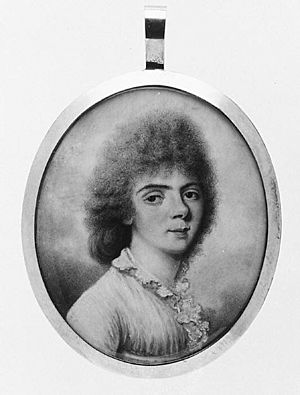
After cutting silhouettes, Isabella learned to paint them. She studied with John Smart, a famous miniature portrait artist. Isabella began painting silhouettes on white backgrounds, like plaster, and often on glass. She also made tiny portraits for jewelry. Her husband, Edward, even learned a special way to gild (add gold to) glass in Italy to help her business.
At her Fleet Street studio, Isabella and her assistants painted many portraits. She was very good at showing the latest fashions in great detail. She painted hair with long, flowing lines, even showing individual hairs outside the main outline. She used many different brush strokes to create curls and give depth to the portraits. She also painted clothing with great skill, using different techniques for frills and details. Sometimes, she even used gold on women's profiles.
By the 1790s, silhouettes were no longer painted on paper as much. In 1792, Isabella advertised that she could create detailed portraits on gold and silver decorated glass, as well as on other materials like ivory. She also made miniature portraits for bracelets, lockets, and rings. Isabella was known as one of the best silhouette artists of her time. People especially admired her ability to capture a person's true features.
Isabella's daughter, Jane, born around 1779, started helping her mother in the early 1790s. Jane often painted on glass. She continued to help until she got married in 1797.
Later Life and Legacy
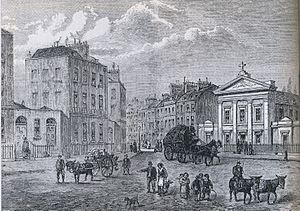
Isabella's husband, Edward, passed away in 1809. Isabella spent her later years living at 9 The Polygon in Somers Town, London. This area was home to many French refugees and people of the Roman Catholic faith. Her daughters also lived there with her. Isabella Beetham passed away in August 1825.
Isabella Beetham's artwork is still highly valued today. In 1991, one of her silhouettes sold for $3,498 at an auction. This shows how important and respected her work remains. In 1995, a private collection of silhouettes included 120 pieces by famous artists like Beetham. The most valuable item in that collection was a silhouette by Isabella, worth about £3,000.
Collections
You can find Isabella Beetham's artwork in these museums:
- Brooklyn Museum, New York
- Metropolitan Museum of Art, New York
- Victoria and Albert Museum, London
See also
- Silhouette artists


